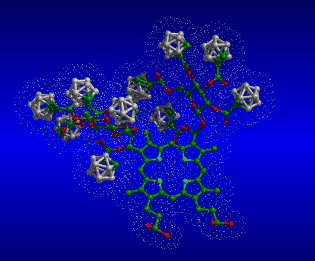
 |
|
 JPEG version (101KB), TIFF
version (526KB)
JPEG version (101KB), TIFF
version (526KB)
Shown is the putative structure of a boronated saccharide porphyrin synthesized in Steve Kahl's laboratory at UCSF by Myong-Seo Koo for possible application in binary therapies for cancer treatment. These include boron neutron capture therapy, in which the boron atoms undergo a fission reaction when exposed to low energy neutrons, and photodynamic therapy, in which singlet oxygen is produced when the porphyrin ring system transfers absorbed photon energy to molecular oxygen. Boron atoms of the carborane cages are shown in white, carbons in green, oxygen in red, and nitrogens in cyan in this structure, one of the most complex porphyrins ever reported.
Standard MidasPlus commands were used to orient the structure to the desired viewing angle, to color code the atoms according to the color scheme described above, and to generate the van der Waals surface. (The original PDB coordinate file is available as boron.pdb). The specific MidasPlus commands used were:
command: open 0 boron.pdb command: colordef mygreen 0 0.75 0 command: color mygreen @c= command: color red @o= command: color cyan :hem@n= command: vdwopt density 0.5 command: vdw command: color white,vThe "neon" command was then used to render the image. Image generation was controlled using a neon.dat control file as described in the documentation for neon in the MidasPlus User's Manual. The key parameters for the image shown here were tubetype=0 (all atoms), atom rendering=1 (ball stick), atom size=20% of the vdw radius, and object thickness=0.05 angstroms (size of the dots forming the vdw surface). The following is the specific neon.dat file used for the image above:
0 |Tubetype |0=all atoms, 1=smooth, 2=bent, 3=straight| 3 |Sphere density |1=rough, 5=high resolution | 1 |Dash flag |0=no dashes, 1=draw dashes | 1 |Object flag |0=no objects, 1=draw objects | 0 |CPK flag |0=normal Render output, 1=CPK output | 0.15 |Stick thickness |Angstroms | 0.50 |Tube thickness |Angstroms | 0.15 |Dash thickness |Angstroms | 0.05 |Object thickness |Angstroms | 0.04 |Density thickness |Angstroms | 1 |Atom rendering |0=stick, 1=ball stick | 0.20 |Atom size |Percent of vdw radius (ball stick mode) | 1 0.50 |Depthcue,Percent |0=n, 1=y; percent aft intensity | 0 0.0 0.0 |B-factor,Range |0=n, 1=shade to color, 2=rainbow; min-max| 1.0 1.0 1.0 |B-factor color |RGB (red, green, blue) | 4 |Number of dashes |Number drawn between each pair of atoms | 1.0 1.0 1.0 |Dash color |RGB (red, green, blue) | 0.30 |Dash offset |Dist. from atom to first dash, Angstroms | 0.00 |Dash/space ratio |0.0=dots, 0.4=dashes, 1.0=solid line | 4.00 |CA conect distance |Angstroms |Lastly, in order to generate the faded background you see here, a conic control file was used. (Note that neon is a preprocessor for conic. Conic is the actual program that renders the final image and any command arguments used with neon get passed on to conic.) The conic control file was named "bgcolor" and simply consisted of the line:
background 0 0 .2 0 0 .8 0 0 .2The MidasPlus command used to invoke neon was simply:
command: neon -F -c bgcolorConic is quite a flexible program and can be used to generate very high resolution digital images in a variety of output formats. For example, to generate a high resolution TIFF image one could do:
command: neon -c bgcolor -f tiff -x 8000 -y 8000 -o outfile.tiff
Chemical synthesis by Myong-Seo Koo. Putative three dimensional structure created by Teri Klein using the UCSF LeAP program and the crystal structure of the boron cage. Image design by Steve Kahl, Julie Newdoll, and Tom Ferrin.
©2004 The Regents of the University of California; all rights reserved.